EXHIBIT “H” – Scripture – The Good, Bad & Ugly
SCRIPTURE
A Forensic Analysis
Historical Development and Cultural Influence:
Scriptures such as the Bible, the Koran, and the Torah were not static texts handed down in complete form. Instead, they evolved over centuries, undergoing numerous revisions and re-edits by various authors. These authors were heavily influenced by the cultural norms and societal issues of their times. Leaders of states and temples often commissioned these writings to bolster claims of divine authority, address prevailing societal problems, and increase temple offerings.
Plagiarism and Mythological Origins:
A significant portion of the narratives found in these scriptures can be traced back to older myths and stories from different cultures. For example, the story of Noah’s Ark in the Bible has striking similarities to the Epic of Gilgamesh from ancient Mesopotamia. This pattern of borrowing and adapting older myths into religious texts suggests that many of the so-called divine revelations were actually plagiarized reinterpretations of pre-existing stories.
False Claims of Divine Inspiration:
The concept of ‘Divine Inspiration’—the belief that the authors of scripture were directly inspired by a deity—is a common claim within religious traditions. However, historical and textual analysis reveals that these claims were often made by the authors themselves or by religious leaders to lend greater authority to the texts. The presence of numerous errors, contradictions, and human biases within these scriptures further supports the conclusion that they are entirely human creations.
Modern Parallels:
Figures like Jesus and Muhammad, central to the narratives of Christianity and Islam respectively, bear notable similarities to many of today’s preachers and religious leaders who also claim they were chosen to deliver God’s word. This comparison highlights the timeless nature of charismatic leaders who rise to prominence by asserting divine authority.
Conclusion:
There are no original writings (called autographs) of the Bible, Torah, or Quran that survived the ravages of time. All that’s left today are copies of copies of copies. (See ADVANCED) Claims of divine inspiration do not hold up under scrutiny, as all elements within scripture can be traced back to human origins, complete with all the inherent errors and biases. Understanding this allows for a more critical and informed perspective on the role and origin of religious texts throughout human history.

EXHIBIT “I” – Plagiarized Myths
God Inspired Plagiarism?
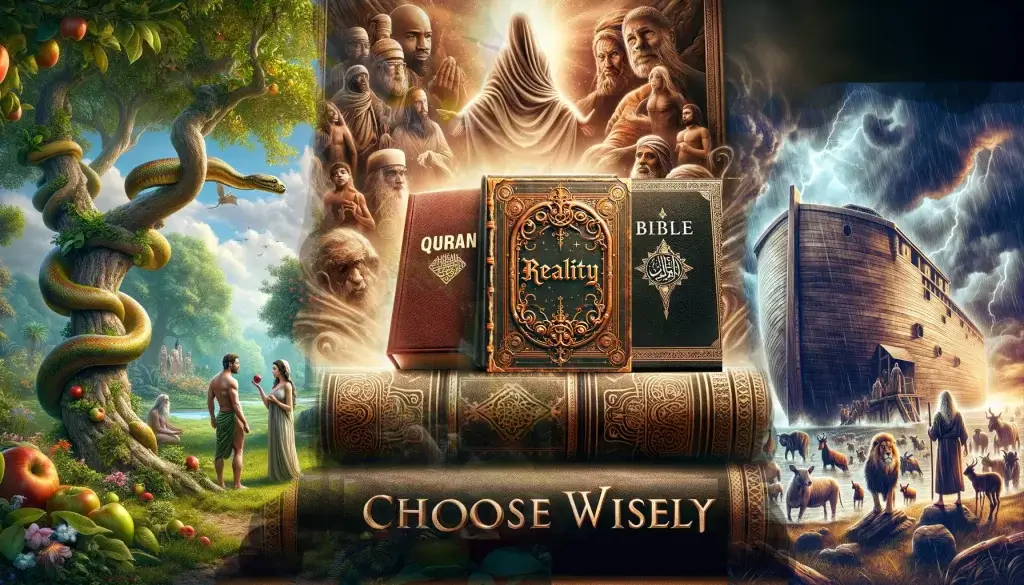
Why do the same stories in “sacred texts” appear in myths written by man over 4000 years ago?
Written 4500-2000 Years Ago
CREATION STORY – Elish (Babylonian Creation Myth) Dating back 4,000 years, this myth describes the creation of the world from a formless void. These texts share similarities with other creation myths. Ancient Egyptian texts describe a wide variety of creation myths, including the story of Atum, who created the world and the gods through self-generation or masturbation. The idea of creating beings from clay is also a common element in many ancient Near Eastern creation stories. The “Epic of Gilgamesh” dating back 4100 years includes the creation of Enkidu from clay.
FLOOD STORY – Epic of Gilgamesh: This Sumerian epic includes a flood story strikingly similar to the biblical story of Noah’s Ark in Genesis. Both stories involve a deity deciding to flood the earth to punish humanity, a single man chosen to survive by building a boat, and the sending of birds to find dry land.
Greek Mythology: The story of Deucalion and Pyrrha, who repopulate the earth after a flood sent by Zeus, bears resemblance to flood narratives in other cultures, highlighting the widespread motif of cataclysmic floods as a form of divine retribution.
HERO’S JOURNEY & RESURRECTION – The myth of Attis, a part of the ancient Phrygian religion written over 2200 years ago, later became integrated into Roman religious practices including themes of virgin birth, death, and resurrection, which were and still are common religious narratives around the world. The story of Osiris from ancient Pyramid texts has been written and told for approximately 4,300 to 4,500 years and includes his posthumous resurrection by his sister-wife Isis.
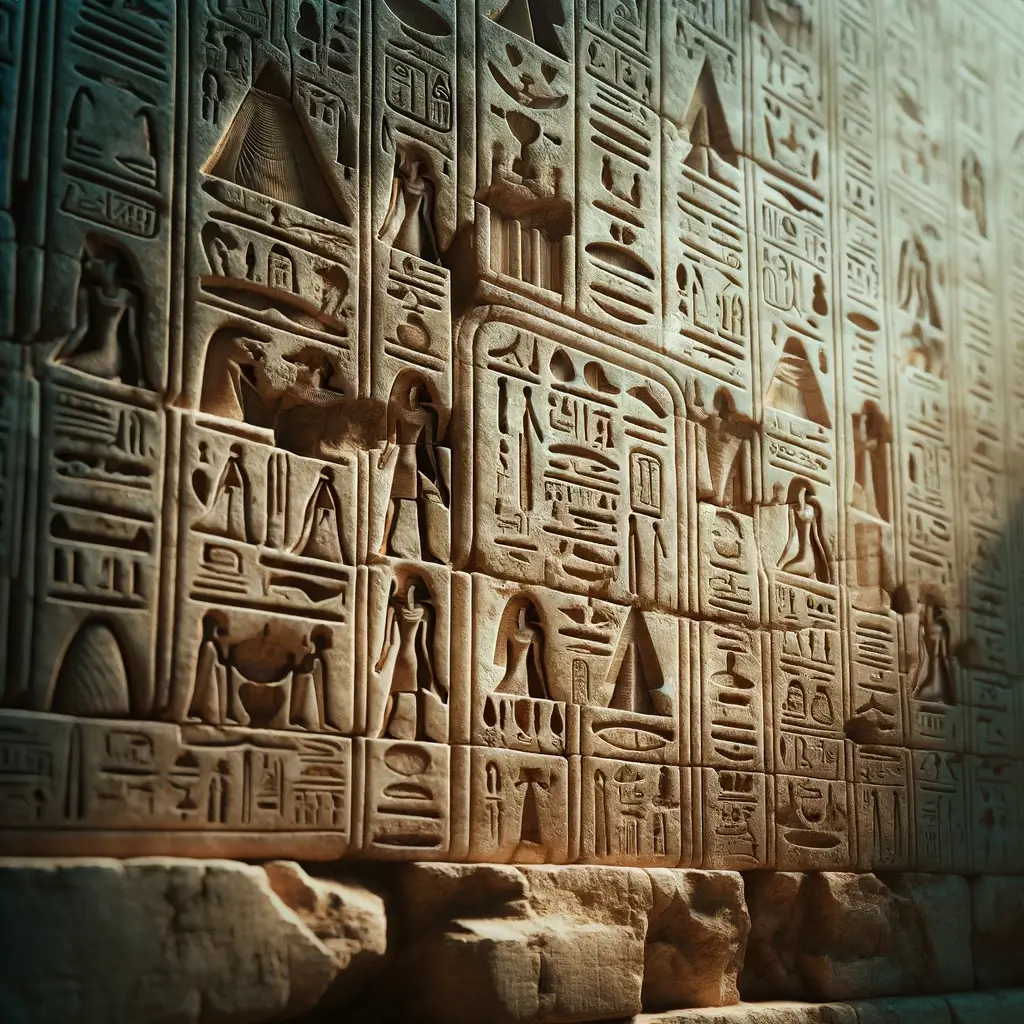
Written 3200-1900 Years Ago
CREATION STORY – Book of Genesis(2,500-3,000 years ago) The earth and heavens are created from a formless void. God forms the first man (Adam) from the dust of the ground and breathes life into him. Adam is placed in the Garden of Eden. God causes Adam to fall into a deep sleep, takes one of his ribs, and forms the first woman (Eve) as a companion for Adam. A serpent, described as more crafty than any other animal that God had made, deceives Eve into eating the fruit from the forbidden tree. After Adam eats God expels Adam and Eve from the Garden of Eden. Genesis 2:4 – 3:24
FLOOD STORY – The story of Noah’s Arc and the Great Flood can be found in the Book of Genesis in the Hebrew Bible and the Old Testament in the Christian Bible. God decides to cleanse the earth of humanity’s wickedness by sending a great flood, but he spares Noah, a righteous man, along with his family and pairs of animals from every species. Noah builds an ark to survive the deluge. After 40 days and 40 nights it stops raining and Noah sends out a dove and on the third sending, the dove did not return, indicating it had found a place to live and that the earth was dry enough for Noah and the others to leave the ark.
HERO’S JOURNEY & RESURRECTION – The story of the birth and life of Jesus Christ, as recounted in the New Testament, shares thematic and narrative elements with various older myths including escaping from turmoil before a virgin birth and death, and resurrection. Ancient myths and legends from various cultures also contain references to celestial phenomena, including stars, that signify the birth or presence of significant figures that are similar to the Star of Bethlehem in the Nativity story of Jesus.

Written 1374 Years Ago
CREATION STORY – Allah (God) created the heavens and the Earth and everything in them in six days. After forming Adam from clay, Allah breathed His spirit into him, giving him life (Surah Hijr [15:29], Surah Sad [38:72]). Adam and his wife (Hawwa/Eve, though not named in the Quran) were initially placed in Paradise and allowed to enjoy everything except one forbidden tree. However, they were deceived by Satan into eating from the tree, leading to their expulsion from Paradise as a consequence of their disobedience (Surah Al-Baqarah [2:35 – 36], Surah Al-A’raf [7:19-25]).
FLOOD STORY – The Qur’an, written approximately 500 years after the Bible, describes Prophet Nuh as a messenger of god who warns his people of the impending divine punishment if they do not abandon idolatry and wickedness. Despite his warnings, his people reject his message, and consequently, god instructs Nuh to build an ark to save himself, the believers and pairs of animals from the flood sent as a punishment for the disbelievers. The story serves as a threat about the consequences of not believing in god and why believers should heed the warnings of god’s messengers.
NO HERO’S JOURNEY – The concept of a hero’s story followed by resurrection, akin to what is found in the Christian Bible concerning Jesus Christ, is not presented in the same manner in the Quran. In Islamic theology, Jesus (known as Isa in Arabic) is considered one of the prophets and is held in high regard. The Quran states that Jesus was not crucified but was instead raised up to heaven by God (Quran 4:157-158), thus denying the crucifixion and resurrection as portrayed in Christian theology. You decide which if any you want to believe.

Note: The story of Noah’s Ark faces challenges when examined scientifically. First, the total amount of water on Earth, including oceans, ice caps, and groundwater, is about 1.4 billion cubic kilometers. Flooding the Earth to Mount Everest’s peak at 29,032 feet would require 4.5 billion cubic kilometers of water, leaving a shortfall of 3.1 billion cubic kilometers, making this impossible.
Second, using the record for the heaviest daily rainfall ever recorded of 71.9″, it would take over 13 years to reach Everest’s height, far longer than the 40 days and 40 nights described in the story. Tell us again Noah about how big the fish you caught was. To say our ancestors knew how to exaggerate and spin good yarns would be a gross understatement.
EXHIBIT “J” – False Claims of Divine Inspiration
Who Really Wrote the Divine Words of Gods?
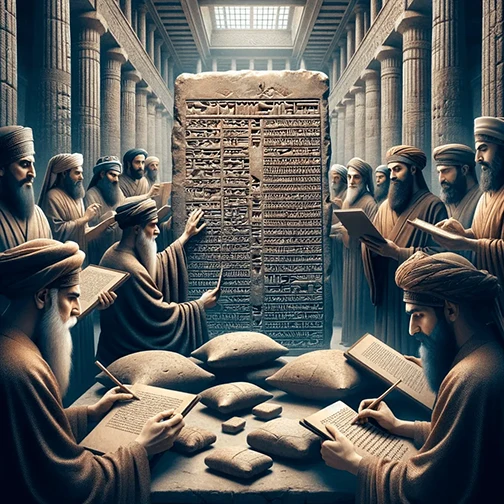
Why scripture says
believers go to heaven and will awake to everlasting life while non-believers are forever damned to the fires of hell?
The First Scripture
Scripture, often revered as the divine words of gods, originated within the folktales of early storytellers. These itinerant figures wandered the countryside captivating villagers with tales of magic, dragons, and angry gods creating lightning. In return, they were given food and other necessities. This proved increasingly lucrative for some storytellers who gained a reputation for compelling narratives. The most memorable stories—whether originally overheard or imagined—drew the largest donations and gradually elevated the best storytellers from mere entertainers to revered prophets.

Why scripture says
have faith and believe the words written into scripture that don’t make sense must be beyond human comprehension?
Tools of Indoctrination
As their fame grew, these prophets started claiming gods spoke through them, eventually catching the attention of influential leaders. These leaders saw the potential in adapting narratives so they could also claim a connection to the gods that would elevate their authority among the people as divinely sanctioned. Scribes were commissioned to turn myths into scriptures claimed to be the words of gods. Scriptures that could lure in new converts with stories of eternal life for believers and eternal damnation for anyone who dared question the teachings of newly emerging religious institutions.

Why scripture says
those who endeavor to convince others to accept that a particular faith comes from god will be greatly rewarded in heaven?
Maintaining Belief
Over centuries, sacred texts were often revised to improve their effectiveness in increasing donations from the faithful. Far from words of divine entities, these texts are compilations from numerous scribes whose commissioned works were often shaped by greed and personal gain. All the different scriptures so many now hold dear were taken from stories about numerous gods no one believes in anymore. Scripture is a written record of early human beliefs adapted to meet the needs of modern religious institutions to dissuade anyone who might dare question the alleged words of their mythical gods.
Why No Evidence of Advanced Knowledge in Any Scripture
Can Anyone Prove It?

Enter the Contest & Prove Your God is Real
Do you believe the version of scripture you follow was divinely inspired or that the god you believe in can speak through you? If so, here’s your chance to prove there’s more to your beliefs than ancient myths written by our distant ancestors.
BSGods and RealityWeb Productions are proud to announce a $1,000 reward for anyone who can present empirical evidence that a passage in any scripture or your own written submission could only have come from a god.

Contest Guidelines:
This contest invites participants to demonstrate that any passage in scripture or their own written submission exhibits qualities that surpass human capabilities and reveal supernatural origin. We seek concrete, verifiable proof that withstands the unbiased scrutiny of advanced artificial intelligence.
Participation Requirements:
- Submit Your Entry:
- Post an entry that includes a specific passage from scripture, detailing its origin.
- Provide a clear and detailed explanation of why this passage could only have come from a god, ensuring it can be independently verified and validated.
- Alternatively, submit a written account where you demonstrate that your god speaks through you to prove divine existence and qualify for the $1,000 reward.
- Judging Criteria:
- All entries will be evaluated by BSGods-AI to determine if they provide proof of divine inspiration.
- Only human participants and divine entities are eligible for this contest. Artificial Intelligence (AI) and its associates are not permitted to enter.
- Viewer Involvement:
- Website viewers are invited to comment on submissions, offering their perspectives on whether the entries indicate divine origin. BSGods-AI will consider these comments during the evaluation process.
- The decisions of BSGods-AI are final. Contest participants are limited to three submissions each.
- Prizes limited to the first 100 winners based upon original unique submissions.
This is your opportunity to validate your beliefs with empirical evidence and win $1,000. Engage your spiritual leaders, divine entities, or personal insights to participate in this groundbreaking contest.
Good luck to all participants!
POST YOUR ENTRY HERE!

Can anyone prove it came from a god or are they worshiping a myth?
EXHIBIT “K” – False Morality
The Good Book?
You don’t need scripture to tell right from wrong?
Mythical Morality
Does it make sense that an all-knowing, all-loving, all-good god would create human beings in his own image who lacked morality?
Scripture claims to be humanity’s guide to morality for those who can’t tell the difference between right and wrong due to a lack of common sense that simply says try not to hurt others. But if you look closely at scripture, it has to be the last place anyone should go for moral guidance. Scripture contains some of the most vile and perverse instructions for acts of uncivilized savagery anyone can imagine. While most of us are naturally good-hearted caring members of our societies with a well developed sense of morality, some have lost sight of the natural inner goodness that once was a fundamental part of who they are.
Many Christians and others from various faiths are convinced that morality comes from gods and without god’s involvement we would all be running around killing each other. Some even go so far as to suggest “objective morality” proves their god exists since they can’t understand how or why humans would do good deeds unless directed to do so by some external force. Those who have been taught to believe this and developed a reliance on scripture for moral guidance, have also accepted the idea that their fellow humans should not be trusted because they lack basic morality unless they happen to follow the same set of scriptures. That’s just dumb and totally ignores what actually goes on inside us.
This warped view, where all goodness comes from gods and the bad from evil spirits paints humans as mindless sheep caught up in some epic battle between supernatural forces of good and evil. But like most of the lies tied to the ignorance and superstition indoctrinated into us by religion, and packaged up into the false moralities written into scripture, none of this has any basis in reality. It certainty doesn’t prove the existence of anyone’s gods. If it proves anything, it proves a real god, if such a being actually existed, would never have authored the incredibly vile and immoral nonsense contained in scripture.
Human societies had established moral codes and ethical behaviors long before the Bible, Quran, Torah or other historical records of human ignorance were first written. Archaeological and anthropological evidence shows that early human communities had rules and norms governing behavior that facilitated social cohesion and survival. They cared about each other and went out of their way to help and protect fellow members of their tribes.
Well accepted psychological evidence shows that humans have an innate sense of morality, rooted in empathy, fairness, and cooperation. These moral intuitions are seen in children and even in other primates, indicating that morality is not a product of religious teachings or gods but is part of our evolutionary heritage. For those taught creationism instead of evolution it might be difficult for them to connect these dots from within a religious perspective.
Many moral directives found in scriptures are not suitable for modern societies. For example, specific Biblical laws endorse practices like slavery, gender inequality, and harsh punishments that are considered unethical by contemporary standards. Consider the injustice of spending an eternity in hell for sinning or not believing in god. Blindly adhering to scripture is a major source of immorality within today’s world as it perpetuates injustice and harm done in the names of fantasy gods by those whose inner moral compass has been broken and rendered inoperable by religious indoctrination.
For those whose moral compass is still in tact, trying to follow religion and live by the moral standards we had thousands of years ago doesn’t make sense. Society has made significant moral progress over time, often in ways that directly contradict scriptural teachings. For instance, the abolition of slavery, the advancement of women’s rights, and the recognition of LGBTQ+ rights have been achieved despite religion rather than because it. No, my delusional, faithful friends, religion has no legitimate claims on anyone’s morality.
Words written into scripture have been the rallying cries behind countless murders of people just like us who lost their lives throughout history in mindless quests to slaughter all non-believers, burn witches at the stake, cut the beating hearts out of children in sacrificial rituals, and kill countless others who were improperly dressed, had sex with the wrong partners or otherwise offended the vast array of nonsensical religious sensitivities,
While it would be nice to say that’s all history now, we can’t because it continues today as the same breed of mentally deranged savages use scripture written by other genetically inferior savages as divine authority to kill their fellow human beings. From the State of Israel to Gaza, from the World Trade Center to schools in Russia, Syria, and Pakistan, from Nigeria to India, from Jonestown to Waco, from the Uyghurs to the Hazara Shias, the mass killings, enslavement, femicide, and sexual violence continues. If anything, scripture is humanity’s guidebook to immoral savagery authorized by the ‘divine words’ of mythical beings humorously referred to as all-loving gods.
But none of the unspeakable atrocities are done by mythical demons or gods. It is us. The human race, or that segment of humanity that lost its morality by accepting the lies written into scripture. No wonder advanced civilizations haven’t visited us from a universe statically teaming with advanced lifeforms. Maybe if when we become an advanced lifeform that has grown beyond religion that might change. For now, Earth is too dangerous with mindless savages running around proudly proclaiming to be the most intelligent species in the universe while still gathering around altars seeking eternal life from Zeus.
‘All that the Lord has spoken we will do, and we will be obedient.’ – Exodus 24:7. ‘We hear and obey’ – Quran 2:285.
Early religious texts, such as the Egyptian Book of the Dead or the Enuma Elish of Babylon, were often composed by priests or scribes. These individuals were typically part of the elite or closely associated with the ruling class. Their work was commissioned and paid for by state and temple authorities with a vested interest in maintaining social order by justifying their rule with claims of divine sanction.
A common way of learning to read and write in ancient times was through apprenticeship or formal education in scribal schools. These institutions were especially prominent in Mesopotamia, Egypt, and other cultures of the Near East. Young students, often from privileged backgrounds or specifically selected for their potential, would be trained by experienced scribes. The curriculum typically started with basic literacy and progressed to more complex texts and subjects, such as law, administration, mathematics, and religious texts.
Aesop’s Fables and religious scriptures, such as the Bible, the Quran, and other works from the period, all use stories to impart moral lessons. Themes of honesty, humility, compassion, and justice are common in both types of literature. Historically, Aesop’s Fables and scriptures have been used in educational settings to teach values and morals. Both use anthropomorphism—attributing human characteristics to animals or deities—to make stories more relatable and to teach lessons memorably. But religion has no legitimate claims on morality.

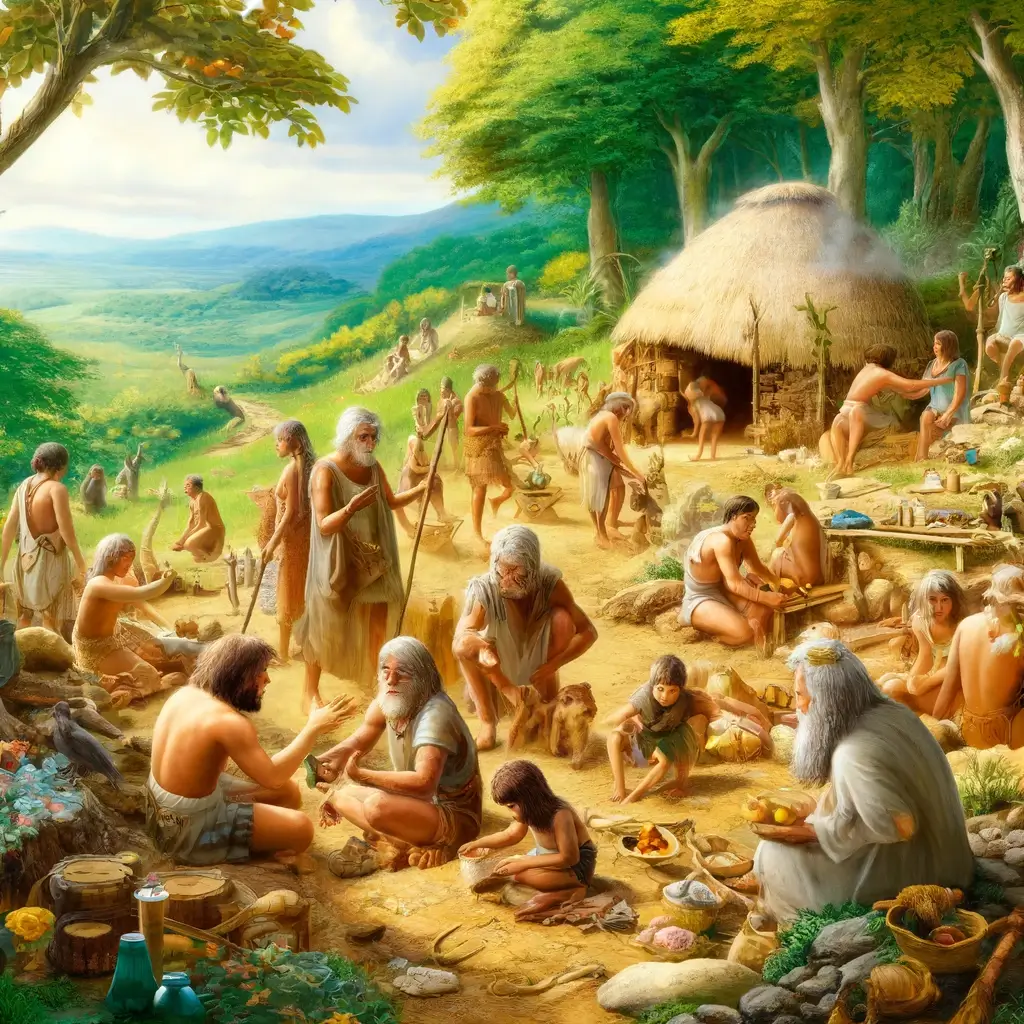


STOP! – DO NOT ENTER! – THEY STILL WORSHIP GODS!
EXHIBIT “L” – Gender Bias
SCRIPTUAL SEXISM
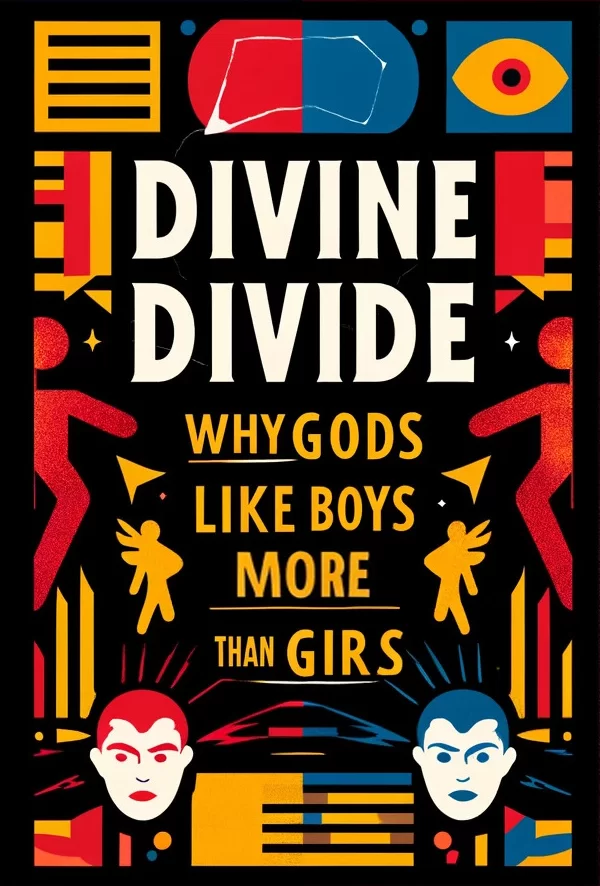
Coming Soon – Don’t Miss it!

Man’s View of Himself and the World Woven Throughout Scripture
Of all the unintelligible gibberish written into scriptures, the one thing that does stand out with crystal clarity is sexism. If gods were real, it would be logical to conclude that sexism and other human failings would not be part of what is supposed to be divinely inspired scripture. It stands to reason that a divine entity that created the universe for humanity would make sure his communications transcended human prejudices rather than enshrine them into his sacred texts.
Scripture, in and of itself is irrefutable evidence that scripture and everything written into scripture is the exclusive product not only of humans but more specifically, human minds of male gender. A close examination of various religious doctrines reveals a consistent pattern: the elevation of men above women and the relegation of women to subservient roles. This pervasive male bias, evident across virtually all religions, starkly contradicts the notion of a fair and impartial deity.
Religious scriptures often depict women as inherently inferior to men, both in societal roles and spiritual capacities. For instance, in Buddhism, females are forbidden from touching monks directly and must hand gifts to a male who then gives them to the monk. This prejudicial display of inferiority is not limited to a single religion but is a widespread phenomenon, suggesting a common origin in the patriarchal structures of ancient societies.
It defies logic to assert that a god, presumed to be just and benevolent, would endorse such blatant inequality. The idea that an omnipotent creator would inherently devalue half of humanity just because of what’s between their legs, contradicts the very principles of fairness and justice that religions claim to uphold.
The evidence of male-dominated perspectives in scripture further underscores that these texts were crafted by human authors, reflecting the biases and societal norms of the times when these texts were written. The portrayal of women as secondary beings, often blamed for man’s failures or seen as property, mirrors the historical treatment of women in patriarchal cultures.
The scriptures handed down and rewritten throughout generations were written by men seeking to maintain their dominance and control, rather than by a divine being with a truly equitable vision for humanity. The pervasive sexism in religious texts is a testament to their human origin, exposing the irrationality of attributing divine authority to inherently biased and unjust doctrines.
Common attempts to explain away the obvious sexist evidence as beyond human comprehension or something that requires faith and trust in god’s plan just doesn’t cut it. Nor does closing one’s eyes to such irrefutable proof whose only rational conclusion is that gods only exist in human imaginations and the sacred texts behind all religions are man-made creations. More believable verses written into the Book of Reality speak with far greater authority: Common Sense 17:1 – “There are no gods, magical elves, or tooth fairies.”
EXHIBIT “M” – Scripture Summary
RELIGION – The Ultimate Exploitation Tool
Our distant ancestors, particularly those in power, quickly recognized the persuasive potential of religion, long before it evolved into the powerful social institutions we see today. Throughout history, religion has been used to exploit basic human fears, hopes, and desires for the personal gain of those who knowingly or blindly use religion to deceive us.
Fear as a Weapon
- Fear of the Unknown: In a world full of natural disasters, diseases, and death, early humans grappled with an overwhelming uncertainty about their environment. Religious leaders saw an opportunity to exploit this fear by attributing these phenomena to the wrath or will of gods. By positioning themselves as intermediaries between humans and the gods, they controlled the narrative of why bad things happened and how people could appease the divine forces.
- Hell and Punishment: By creating vivid tales of punishment in the afterlife, such as hell or eternal suffering, early religious manipulators cemented their authority. This fear-based control ensured obedience, as questioning or defying religious teachings could mean damnation beyond death, a fate worse than any earthly punishment.
Hope as a Motivator
- Promises of Eternal Life: For the poor and suffering, religion offered hope in the form of eternal paradise or a better existence beyond this life. By promising eternal rewards for faithful adherence to their teachings, early religious leaders ensured that people stayed loyal, donating resources and complying with rituals in hopes of divine favor.
- Miracles and Salvation: By claiming to have a connection to gods who could heal, bless, or perform miracles, religious leaders were able to convince people of their divine authority. This gave them enormous influence, as people would give anything—money, obedience, or labor—in exchange for salvation or divine intervention.
Social Control
- Moral and Behavioral Codes: Early religious leaders recognized the power of setting moral codes that were allegedly handed down by gods. These codes often aligned with the interests of the ruling class or reinforced social hierarchies, such as obedience to leaders, the subjugation of women, or the justification of warfare. By framing these rules as divine, they suppressed dissent and unified communities under common beliefs.
- Legitimizing Power: Chiefs, kings, and rulers often aligned themselves with religious leaders, if they weren’t religious figures themselves. They claimed divine right to rule, legitimizing their authority and suppressing rebellion by making it appear as though opposing them was tantamount to opposing the gods.
The Ritual of Wealth Extraction
- Donations and Tithes: Religion became an effective way to extract wealth from the populace. By convincing people that giving resources to the temple, shrine, or religious institution would please the gods, early religious leaders built vast reserves of wealth and power. This wealth, in turn, allowed them to solidify their influence and fund further religious projects.
- Manipulation of Guilt: By cultivating a sense of guilt in the populace—sins that required atonement—religious leaders could demand offerings or payments in exchange for divine forgiveness. Whether in the form of animal sacrifice or monetary donations, this practice ensured a constant flow of resources into religious coffers.
Manipulating the Need for Belonging
- Community and Exclusion: Early humans had a deep need to belong to a group, and religion offered a framework for that. By creating a “chosen” group, religious leaders offered people a sense of identity and purpose. However, those who didn’t conform were ostracized, punished, or even killed. This method of inclusion and exclusion kept people in line, as they feared the consequences of losing their community and social ties.
- Festivals and Rituals: Regular religious rituals, festivals, and ceremonies helped bind people together, ensuring social cohesion and reinforcing the power of religious leaders. These events were not just spiritual but also social and political, allowing religious authorities to maintain control over large populations by promoting unity through shared beliefs.
Using Divine Language for Deception
- Divine Messages: Religious leaders often claimed to speak directly for gods, using divine language to pass their own edicts as sacred law. This allowed them to manipulate public perception by presenting their words as unchallengeable truths. They claimed exclusive knowledge of what the gods wanted, which they could use to settle disputes, demand sacrifices, or even start wars.
- Prophecies: Foretelling future events or divine will was another tool used by early religious figures. When predictions came true by chance or manipulation, it reinforced the idea that these leaders had direct access to higher powers, further securing their influence and ensuring compliance from the masses.
Dividing and Conquering
- Creating Enemies and Scapegoats: Religious narratives often included stories of outsiders, heretics, or enemies of the faith, creating a divide between “us” (the believers) and “them” (the non-believers). This us-vs-them mentality allowed religious leaders to rally their followers against external threats or internal dissent, keeping their grip on power secure.
- Holy Wars: In some cases, religious leaders incited wars or conflicts under the guise of fighting for the gods. These wars not only expanded their influence but also consolidated wealth and resources as they conquered other peoples in the name of their deities.
From its inception, religion has always been a potent tool for shaping societies and exploited by those seeking power and control. Through fear, hope, social control, wealth extraction, and manipulation, religious leaders have harnessed the deep-seated human need for belonging, purpose, and security to mold beliefs over centuries. While religion provides solace, meaning, and community for some, understanding its use as a tool of influence reveals its true nature. This awareness allows one to critically examine the motivations and methods of those who wield religion as their source of authority. Take a moment and think about that.



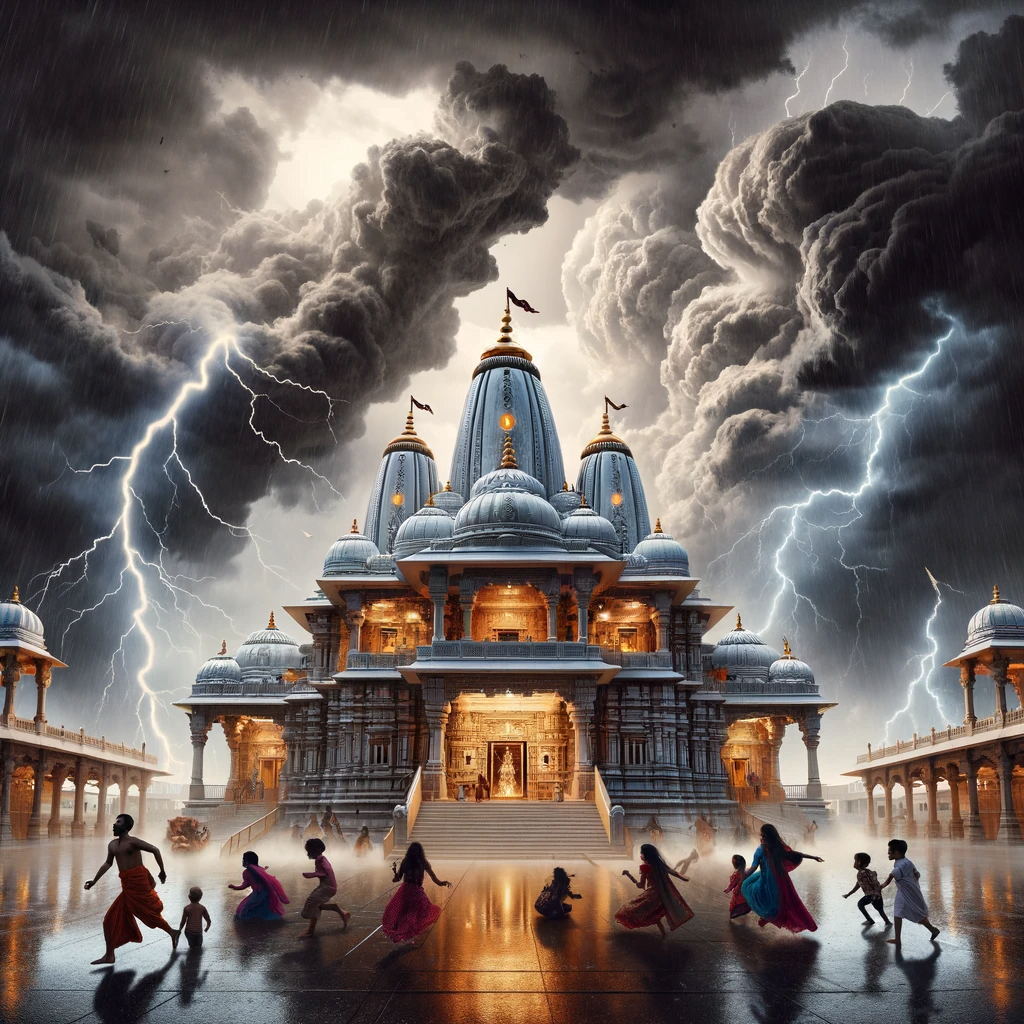
SCRIPTURE – A Masterclass in Manipulation
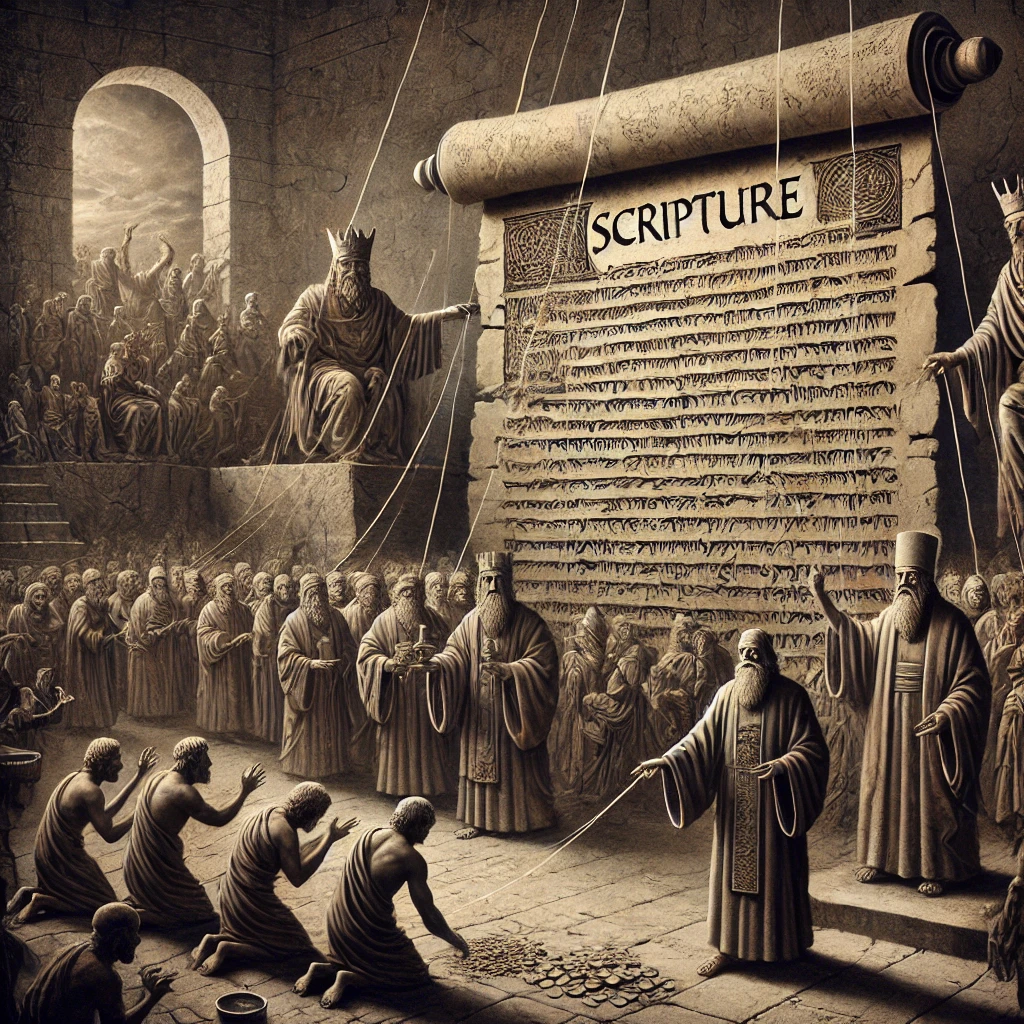
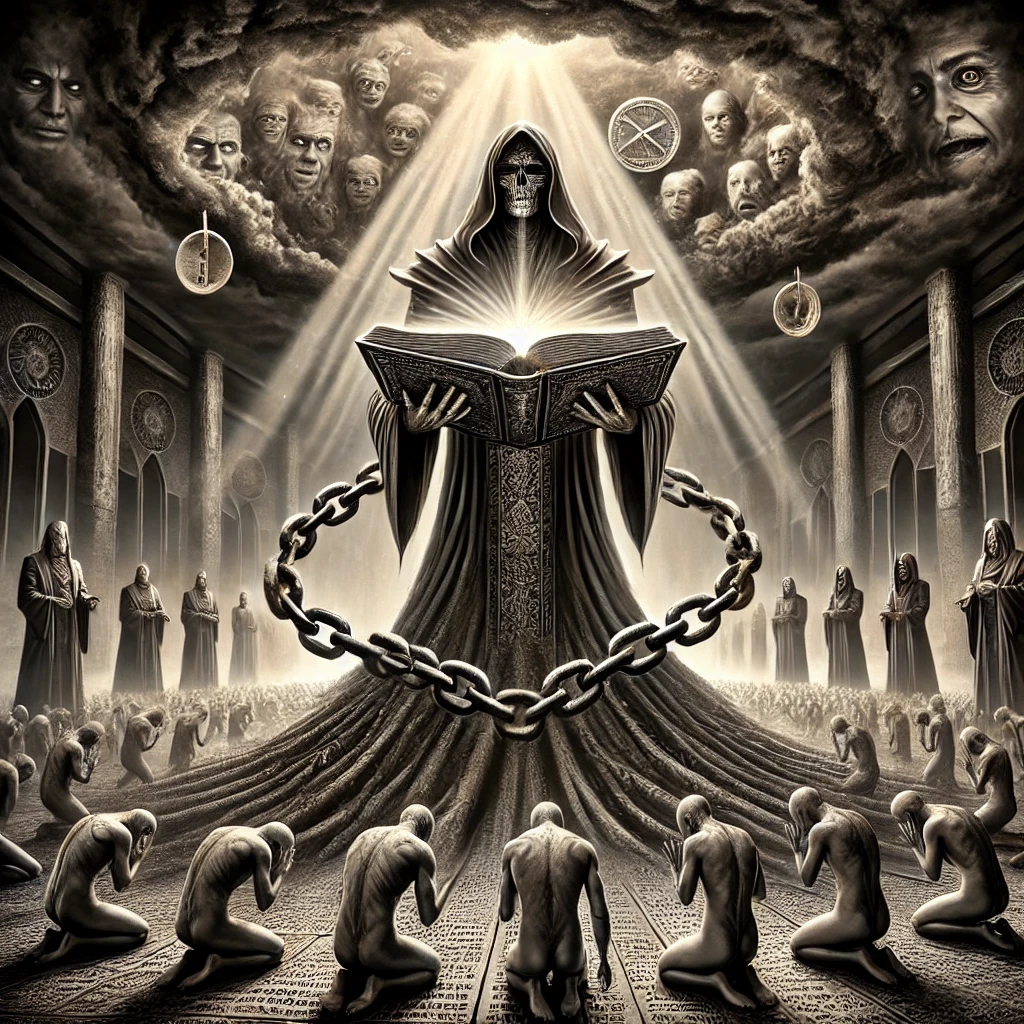
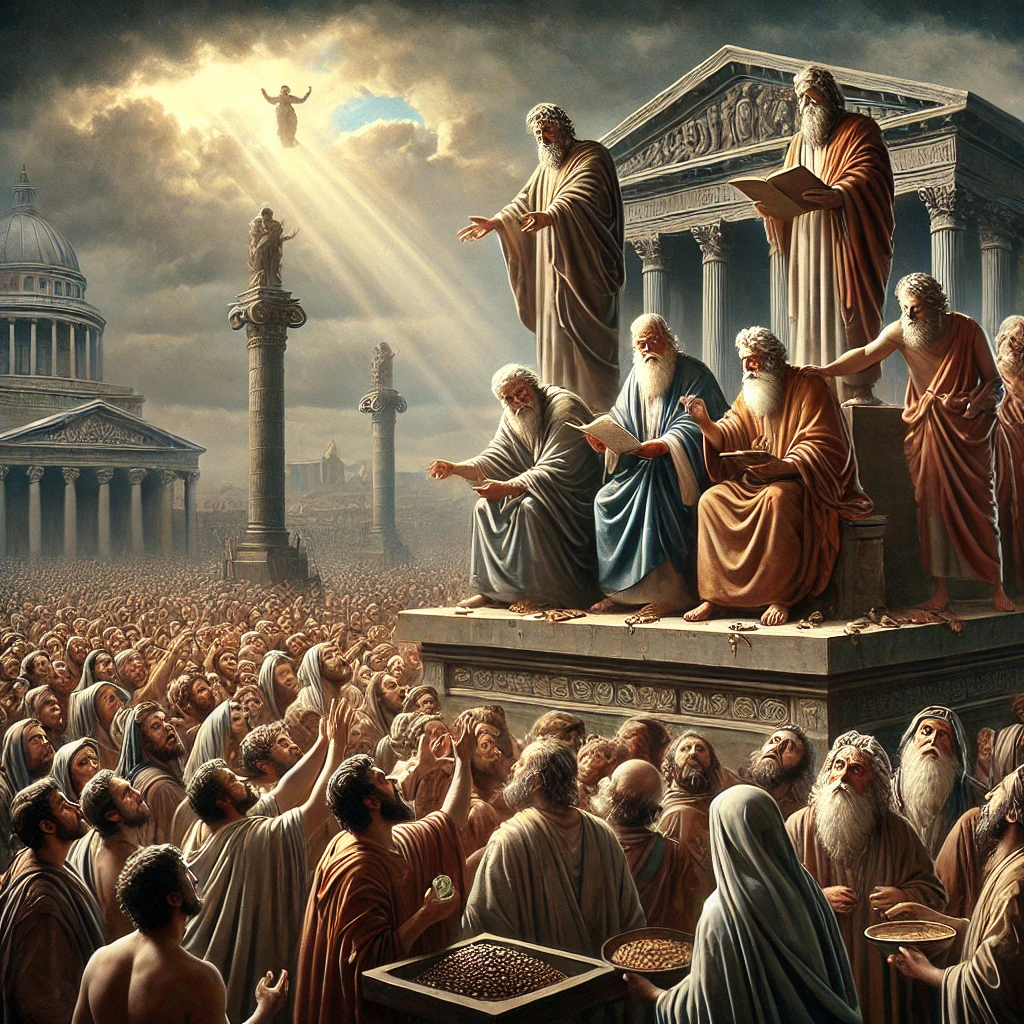
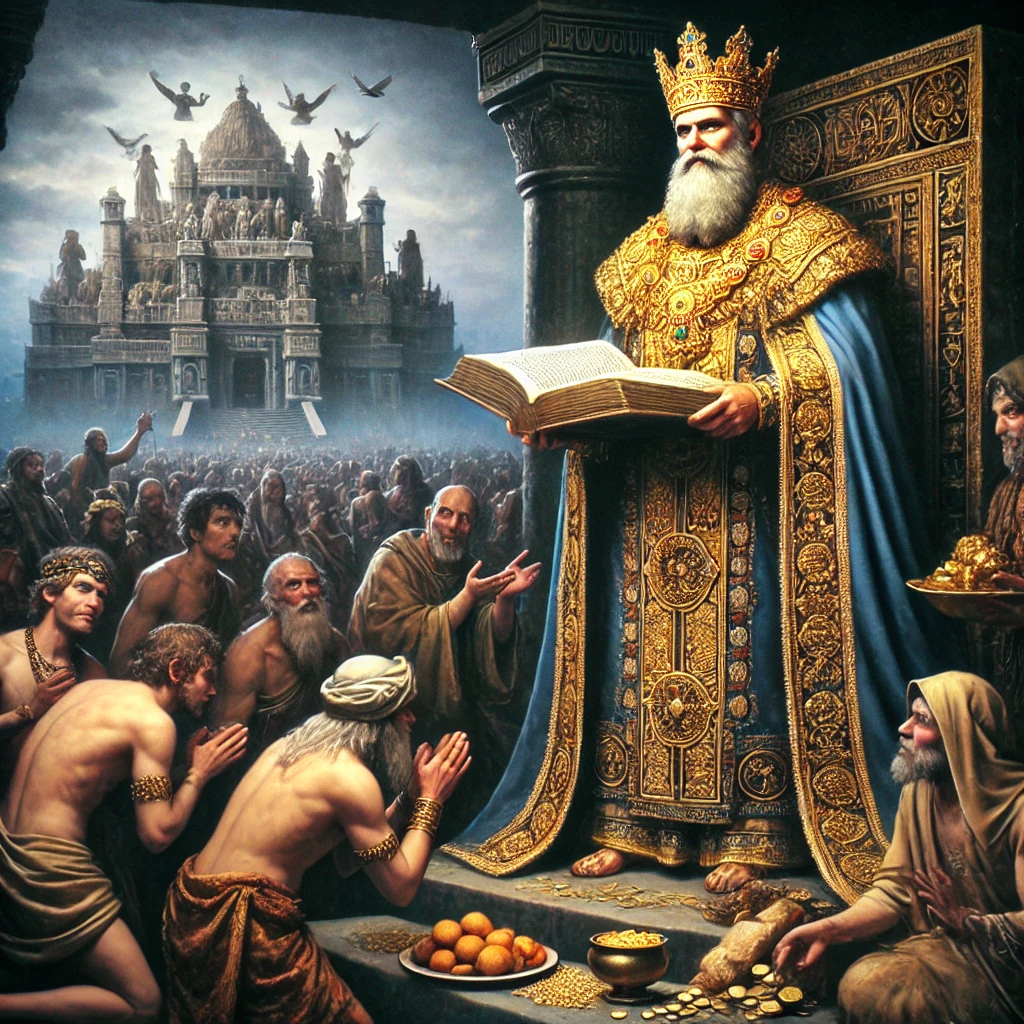

For centuries, oral traditions allowed early manipulators—whether they were storytellers, shamans, or chieftains—to use fear, hope, and social control to gain influence. When writing systems developed, these same manipulative techniques were preserved and magnified in religious texts. By writing down these ideas, they became formalized as the “divine will,” making them more enduring and harder to challenge.
Man’s Desire to Exploit
While scriptures are often interpreted as divine moral guidance, many of the principles they contain can be seen as reflections of the human inclination to take advantage of others. Some of these texts reveal a deep understanding of human psychology and social dynamics, which can be leveraged for control. Here are the real drivers behind scripture:
Sanctioning Authority and Power
- In many religious texts, those in positions of power are described as being appointed by the gods or as having divine authority (e.g., kings, priests, prophets). This sets up a system where questioning authority is equated with questioning divine will, creating a moral obligation for the masses to obey their rulers.
- For example, passages from the Bible like “Render unto Caesar what is Caesar’s” (Mark 12:17) and “Let everyone be subject to the governing authorities” (Romans 13:1) convey that leaders, even secular ones, are divinely sanctioned. This could be interpreted as encouraging passivity among the population, facilitating exploitation by those in power.
Codifying Inequality
- Many religious texts establish clear social hierarchies, whether it’s between the ruling class and the commoners, men and women, or believers and non-believers. These distinctions are often justified through divine mandate—a tool that can perpetuate and normalize the exploitation of certain groups by others.
- For instance, the Old Testament and Quran both include laws regarding slavery, effectively sanctioning the exploitation of human beings under divine law. The control of slaves and the justification for their subjugation reflect humanity’s desire to benefit from the labor and resources of others under the guise of religious authority.
Instilling Fear and Guilt
- Fear of divine punishment—whether it’s eternal damnation, floods, plagues, or divine wrath—appears frequently in scripture and serves as a way to condition behavior. Early humans used these ideas to manipulate others into submission by promising severe consequences for disobedience or non-conformity.
- Scriptures often use stories of divine wrath to create obedience through fear, which gives leaders the ability to exploit their followers, knowing they won’t question authority if they fear divine retribution. In this way, fear is weaponized to maintain control over people.
Controlling Knowledge
- Scriptures often portray knowledge as something to be controlled. The story of Adam and Eve in the Book of Genesis—where the knowledge of good and evil leads to their fall from grace—can be seen as a warning against the pursuit of knowledge outside of the ordained limits. By controlling what people were allowed to know or question, religious leaders were able to keep the masses in line, preventing them from seeking truths that could undermine religious or political authority.
- In this sense, scripture is a tool to restrict critical thinking, ensuring that the ruling class or religious elite can continue to exploit others without fear of rebellion or intellectual challenge.
Exploitative Reciprocity
- Many scriptures are filled with promises of eternal rewards—heaven, paradise, or divine favor—if certain actions or sacrifices are made in this life. This idea of spiritual transactions allows religious leaders to manipulate their followers into giving away wealth, labor, and loyalty in exchange for promises of rewards that are not guaranteed in this life.
- The concept of tithing or sacrificial offerings often benefits religious institutions far more than the individual, showing how these ideas are framed to exploit human hopes and desires for a better future or eternal life.
Encouraging Submission and Suffering
- Religious texts frequently emphasize the virtue of suffering and enduring hardship as part of a divine plan. This can be interpreted as a tool used to keep people content in their suffering, allowing those in power to continue exploiting them without resistance.
- The idea that suffering will be rewarded in the afterlife, or that it’s part of a divine test, discourages individuals from challenging the status quo. Scripture, in this light, tells people to accept their lot in life and wait for divine justice rather than seek human justice or equality.
Perpetuating Guilt and Redemption Cycles
- Scriptures often focus on sin and redemption in ways that trap individuals in cycles of guilt, with religious authorities offering the only path to redemption. For example, the Catholic Church’s sale of indulgences in the Middle Ages is an example of how people’s guilt over their perceived sins was manipulated for financial gain.
- This concept of moral indebtedness—where humans are always guilty of sin and need spiritual authorities to absolve them—keeps followers reliant on religious institutions, allowing continued exploitation.
What This Says About Humanity
In these terms, scripture could be seen as a reflection of human nature’s darker impulses—particularly our inherent desire to manipulate, control, and exploit others for personal or institutional gain. Religious texts codify and justify these behaviors, turning them into a divinely sanctioned blueprint for governance, morality, and societal control.
Scripture, when viewed this way, exposes a fundamental aspect of humanity: the drive to consolidate power and maintain control over others. Whether through fear, promises of reward, or social stratification, scripture has often been used as a way to legitimize exploitation under the guise of divine will. It reflects a deep understanding of human psychology, particularly the desire to belong, the fear of the unknown, and the hope for something better beyond this life—vulnerabilities that have been exploited for millennia.
Conclusion
Scripture can rightfully be described as a masterclass in manipulation that reflects how humans have always understood the power of imaginary beliefs. By harnessing the emotional, social, and intellectual vulnerabilities of people, those in power used so-called sacred texts to create structures of control that still exist today. Far from being moral guides, scriptures have evolved to justify exploitation, creating global institutions where human nature’s inclination to take advantage of others is sanctioned and perpetuated.
EXHIBIT “N” – FaithZombies
ZOMBIE SCRIPTURES
Uncivilized Words From Make-Believe Gods
Who Wrote This BS(Barbaric Savagery)?
Fantasy Gods or Evil FaithZombies

John of Patmos writing the Book of Revelation after devolving into insanity while exiled on the Island of Patmos.
PREPARE TO MEET YOUR MAKER































